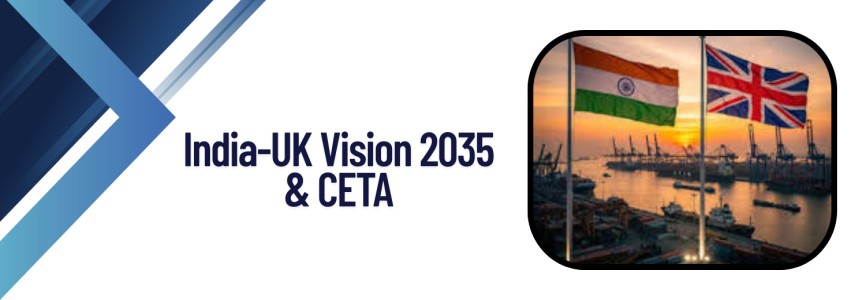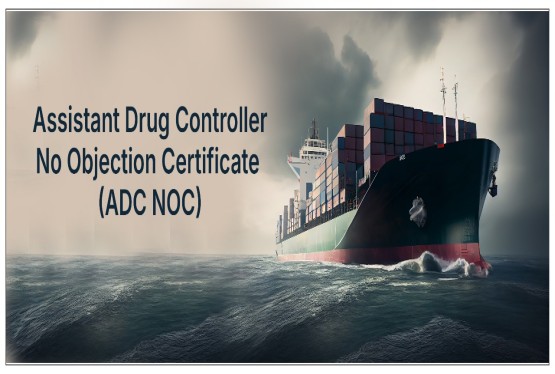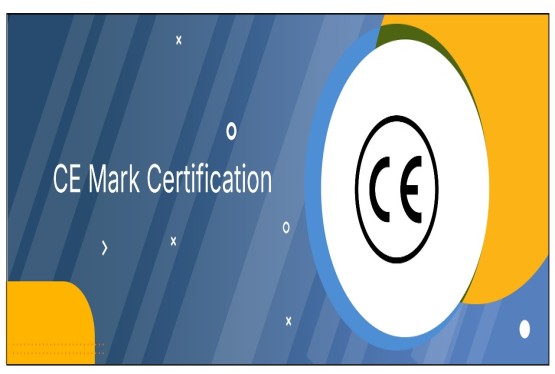On 24th July 2025 in a landmark development, India and the United Kingdom have reaffirmed their strong and evolving bilateral relationship through the announcement of the India–UK Vision 2035 and the signing of a historic Comprehensive Economic and Trade Agreement (CETA). The announcements were made during Prime Minister Narendra Modi’s official visit to London, where he met with UK Prime Minister Sir Keir Starmer. Together, they unveiled a future-focused roadmap aimed at unlocking the full potential of a Adaptable and strong partnership.
A New Era of Strategic Cooperation
The India–UK Vision 2035 builds upon the foundation of the Comprehensive Strategic Partnership launched in 2021 and outlines a renewed commitment to collaboration across five key dimensions: Business, Research, Innovation, Science and Technology, and Knowledge (BRISK). This long-term framework aims to shape a secure, sustainable, and inclusive global future.
Both countries committed to a shared strategic outlook through annual high-level political engagement and ministerial dialogues across sectors such as trade, defence, technology, and climate. The implementation of Vision 2035 will be reviewed annually by India’s External Affairs Minister and the UK’s Foreign Secretary to ensure consistent progress and timely delivery.
Comprehensive Economic and Trade Agreement (CETA)
The signing of the CETA marks one of the most ambitious trade pacts between India and a major Western economy post-Brexit. It is expected to significantly boost bilateral trade, currently valued at USD 56 billion, and aims to double this figure by 2030.
Features of CETA:
-
Tariff elimination on 99% of Indian exports to the UK, benefiting sectors like textiles, marine products, gems and jewellery, leather, and footwear.
-
Enhanced market access for UK goods in India, including aerospace parts, medical devices, and Scotch whisky.
-
Ease of movement for Indian professionals, including contractual service providers such as chefs, engineers, architects, yoga instructors, and IT specialists.
-
Introduction of the Double Contribution Convention (DCC), exempting Indian workers and their employers from UK social security contributions for up to three years improving take-home pay and business competitiveness.
-
Dedicated chapter on trade and gender, empowering women-led enterprises and promoting gender-inclusive trade.
This agreement is expected to stimulate job creation, enhance consumer access to high-quality goods, and deepen India’s integration into global value chains.
Components of the India–UK Vision 2035 and CETA Framework"
These are some major key components of this CETA frame work between India - UK:
Driving Growth and Investment
India and the UK are working closely to uplift economic ties in a big way. One of their key steps is bringing back a stronger Joint Economic and Trade Committee (JETCO) to keep track of how well the CETA trade deal is being carried out. They’re also strengthening important platforms like the Economic and Financial Dialogue (EFD) and Financial Markets Dialogue (FMD) to ensure financial stability and smooth coordination between both sides.
The partnership is especially focused on supporting MSMEs, startups, and the creative industries, encouraging innovation through joint hubs and business-led projects. On the finance side, both countries are joining hands in areas like capital markets, green finance, digital trade, and asset management. And to make sure there’s real funding behind these efforts, bodies like British International Investment (BII) and the UK-India Development Capital Investment Partnership will help channel investments into green energy, infrastructure, and sustainable development.
Technology, Research, and Innovation
Under Vision 2035, India and the UK are building a strong tech partnership through the UK-India Technology Security Initiative (TSI). This collaboration is all about using technology for real-world impact. One of the major highlights is the launch of a Joint AI Innovation Centre, which will focus on developing ethical and practical applications of artificial intelligence. The two countries are also teaming up in critical and emerging areas like telecom security, 6G, semiconductors, quantum tech, biotech, and access to important minerals the building blocks of future tech.
Health and science are also a big part of this alliance. India and the UK will work together on digital health tools, vaccines, bio-manufacturing, and advanced medical technologies. They're even setting up a new India-UK Connectivity Innovation Centre to drive joint digital projects and strengthen cybersecurity cooperation. On the defence side, a dedicated export and tech dialogue will help streamline licensing and give both countries better access to high-end defence and aerospace technologies. Altogether, this tech alliance is about combining strengths to innovate, secure, and grow together
Defence and Security: Deepening Trust
In response to growing regional and global security challenges, India and the UK have laid out a 10-Year Defence Industrial Roadmap to deepen their defence partnership. At the heart of this plan is the co-development of cutting-edge military technologies, including electric propulsion systems and jet engine cores, which could shape the future of defence innovation. The two nations are also stepping up their defence cooperation through regular joint military exercises and improved interoperability across all branches of the armed forces, ensuring they can operate seamlessly together when needed.
To strengthen their strategic alignment, they’ve upgraded their Foreign and Defence 2+2 dialogue, allowing for more structured and high-level coordination. Maritime security is another big focus, with both countries working closely under the Indo-Pacific Oceans’ Initiative and planning to establish a Regional Maritime Security Centre of Excellence. Beyond traditional defence, India and the UK are also taking a firm stand against modern threats pledging to combat terrorism in all its forms, boost cybersecurity, and tackle transnational crime through better coordination between their law enforcement and judicial systems. It’s a complete security partnership built on trust, technology, and shared global responsibility.
Clean Energy and Climate Leadership
India and the UK are working hand in hand to fight climate change, with clean energy and sustainability at the core of their partnership. Both countries share strong net-zero commitments, and they’re taking practical steps to get there. This includes collaborating on key green technologies like energy storage, offshore wind, and green hydrogen, which are essential for building a cleaner future. They also plan to reform global financial institutions to unlock affordable climate finance, making it easier for developing nations to go green.
Innovation is a big part of their plan, and through the Net Zero Innovation Partnership, both sides aim to develop and scale climate-friendly solutions. India and the UK are also joining forces on global platforms such as the International Solar Alliance, CDRI, and OSOWOG, to promote renewable energy and disaster-resilient infrastructure worldwide. Additionally, they’re working together on sustainable land use and forest protection through the India-UK Forest Partnership. Overall, this cooperation is about more than just hitting climate targets it’s about driving inclusive, green growth and building a climate-resilient future for both nations and the world.
Education and People-to-People Ties
India and the UK recognize that education and cultural exchange are at the heart of a strong and lasting partnership. That’s why, under Vision 2035, both countries are taking big steps to build human capital and connect their people more deeply. One such initiative is the launch of an Annual Ministerial Education Dialogue, which will help align education policies and open up more opportunities for students and institutions on both sides. The UK is also encouraging its universities to set up campuses in India, while expanding joint and double degree programs to give students a truly global learning experience.
To prepare the workforce for future industries, the two nations are implementing the India-UK Green Skills Partnership, aimed at bridging skill gaps in areas like renewable energy, sustainability, and digital tech. They’re also making it easier for young people to explore new opportunities through the Young Professionals Scheme and the Study India Programme, which promote youth mobility and cultural exchange. Further, the Mutual Recognition of Qualifications agreement will ensure that academic degrees and certifications are respected in both countries, making education and career paths smoother for students. At its core, this collaboration is about more than policy it's about connecting people, sharing knowledge, and building a brighter future together.
Global Governance and Shared Values
India and the UK have come together with a shared commitment to uphold a rules-based international order, one that reflects today’s global realities and challenges. Both nations agree that it's time to reform key global institutions starting with the United Nations Security Council, to make it more inclusive and representative of the modern world. They’ve also pledged to strengthen other multilateral bodies like the WTO, WHO, IMF, and the Commonwealth, ensuring these platforms remain effective, fair, and responsive to global needs.
In addition, India and the UK are stepping up to set and support international standards in crucial areas such as tax transparency, digital governance, and supply chain resilience. By doing so, they aim to promote greater trust, accountability, and cooperation across nations building a stronger, more stable global framework that benefits everyone.
Conclusion
The India–UK Vision 2035 and the Comprehensive Economic and Trade Agreement (CETA) collectively represent a significant recalibration of bilateral ties, embedding within them a framework for long-term strategic, economic, and geopolitical cooperation. These instruments go beyond the conventional contours of trade agreements and diplomatic statements, embodying a mutual aspiration for inclusive development, technological advancement, regulatory alignment, and sustainable progress.
As articulated by Prime Minister Narendra Modi, this is “not merely an economic partnership, but a blueprint for shared prosperity.” With enhanced institutional mechanisms, reinforced trust, and clearly defined pathways for implementation, India and the United Kingdom are poised to act as co-stakeholders in global governance and joint custodians of a rules-based international order. This partnership, anchored in mutual respect and sovereign equality, stands as a model for forward-looking bilateral engagement in the 21st century.
Frequently Asked Questions (FAQs)
Q1. What is the India-UK Vision 2035?
Ans. India-UK Vision 2035 is a strategic roadmap jointly developed to deepen bilateral relations across trade, climate change, innovation, education, defense, and health, aiming for long-term cooperation and sustainable growth.
Q2. What does CETA stand for in the India-UK context?
Ans. CETA refers to the Comprehensive Economic and Trade Agreement, a framework aimed at enhancing trade, investment, and regulatory alignment between India and the UK as part of broader economic collaboration.
Q3. How does Vision 2035 benefit both India and the UK?
Ans. Vision 2035 promotes collaboration in sectors such as technology, green energy, defense, pharmaceuticals, and education, while also facilitating smoother trade and investment flows between the two economies.
Q4. Is there a formal agreement signed under Vision 2035?
Ans. Vision 2035 serves as a strategic intent document and policy alignment framework. It may be supported by individual MoUs, trade deals, or cooperation agreements signed progressively under its agenda.
Q5. How does Vision 2035 align with CETA?
Ans. Vision 2035 provides the strategic direction, while CETA acts as a trade instrument to operationalize shared economic goals, helping align standards, reduce tariffs, and promote ease of doing business.
Q6. What are the focus sectors under India-UK Vision 2035?
Ans. Key sectors include green technology, defense and cybersecurity, digital innovation, healthcare and pharmaceuticals, education, AI, fintech, and infrastructure development.
Q7. Will Indian SMEs benefit from CETA?
Ans. Yes, CETA is designed to reduce trade barriers, simplify regulations, and improve market access for small and medium enterprises (SMEs) in both India and the UK.
Q8. Is CETA similar to an FTA?
Ans. Yes, CETA functions like a Free Trade Agreement, focusing on tariff reduction, investment protection, and intellectual property cooperation, though it is still under progressive negotiation and review.
Q9. What role does climate cooperation play in Vision 2035?
Ans. Sustainability is a key pillar of Vision 2035, with both nations committed to green energy transition, carbon neutrality goals, and joint R&D in climate-resilient technologies.
Q10. How can businesses leverage India-UK Vision 2035?
Ans. Businesses can align with government-backed initiatives, explore new trade and investment opportunities, participate in bilateral innovation programs, and benefit from harmonized regulations and standards.












































































_crop10_thumb.jpg)







_Rules,_2025_learn_crop10_thumb.jpg)
























































































_crop10_thumb.jpg)








 in BIS FMCS_learn_crop10_thumb.jpg)










_crop10_thumb.jpg)















_crop10_thumb.jpg)





_Code C-888_learn_crop10_thumb.jpeg)
_learn_crop10_thumb.jpg)

































































_Certificate_learn_crop10_thumb.jpg)

_Certificate_(1)_crop10_thumb.jpg)















_learn_crop10_thumb.jpg)

_crop10_thumb.jpg)


















_Scheme_learn_crop10_thumb.jpg)


_learn_crop10_thumb.jpg)









